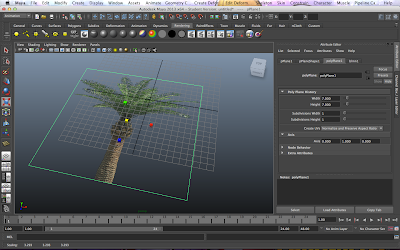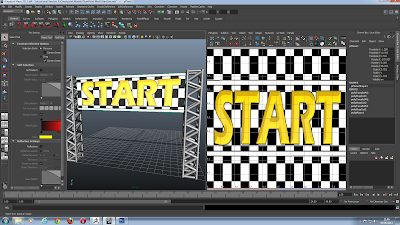Today Tim and me made a start on the track parts, at first we thought we were doing okay with the track parts, but after an hour or two we came into massive amount of problems. The idea was to make track parts within Maya and import them piece by piece and connect them all together in Unity 3D like a scalextric set. The track parts we had made, had size problems along side many other construction problems.
(Example of Straight made and texture by me)
I'd only manage to make a straight track part with many lumps and bumps to provide some terrain to the track, but as for any bends or corners we had major problems. We had no layout or track to follow, so we were making our track parts by eye, which caused the first part of the problems. We also ran into the track deforming itself when it came to bending the track parts, making the track fin and unsuitable.
(Example of attempt at making a bend with the level design to guide me, this failed)
This really worried us as we wanted to get the track parts textured and pieced together within Unity, but because of all the problems we had including delays because of other modules, we have greatly fallen behind.
*IMPORTANT UPDATE*
Discussion with Rob
After discussing our worries with Rob, our Final Major Project Idea has been redesigned, so we are no longer making an arcade game that players can sit down and play/drive. Our new idea that we are creating for our Final Major Project is to create a game trailer and showreel of our game, displaying all of our made assets, such as our designs, models, sound, music and gameplay.
This new idea means I do not have to code in unity for my music and sound effects, but my models and some of my music/sounds will still be used and displayed within the game trailer and showreel video.
23rd May
Recording for our theme tune of our game and voice overs.
Today I booked out the studio to record our theme tune, and voice overs needed for our game. Tim, Matt and me would be singing within our theme tune so this would be a great deal of fun.
I had already collected and edited an instrumental theme tune from Sega Rally Championships game, which I placed within Logic ready for everyone to sing to. We would be singing the same lyrics to the original singers from the Sega Rally Championship game but with a slight change, we would be singing Jäga Rally instead of Sega Rally.
This link is the original version that we are copying: http://www.youtube.com/watch?v=mywEY4ByuhA
(We are aware that the music used for our theme tune was not created by us and we do not own the rights to the music, we are not claiming the music as are own or selling it for commercial release, only for the use of our module)
Before I started recording our great singing voices, I needed to record and make the Jäga Rally title screen tune, this is very much like Sega titles screen tune used within their games, but with Jäga being pronounced not Sega.
Example of Sega's title tune
http://www.youtube.com/watch?v=AHPzki6e5S8 (This tune but with Jäga)
We did two takes of the title tune with all three of us singing down the AKG Microphone. The first take was a low Jäga call, the second was a high Jäga call. Mixing both of these recorded pieces together formed a satisfying tune. To make our Jäga title tune sound more representative of Sega's title tune, I added distortion by using guitar plugins within logic, this helped make our voices sound compressed just like the 16 bit Sega title tune. I also tried to copy the drum beat and synthesisers used in the Sega title tune so that are tune would be representative to Sega's
(Example of guitar plugin settings that provided the distortion I needed)
I then moved onto the Jäga Rally title screen commentary, this is just a voice over of someone saying the title of the game. Most arcade games have some form or another of getting their game name across, so that players can be alerted and informed of the title of the game. For this It was just Matt on his own, Matt would be the commentator of our game, so getting him to do a cheesy dark phrase of our title would be perfect. To make Matt's voice sound that little more cheesy and dramatic, I then added reverb to his voice to emphasize his speech.
To make the title/commentary of our game that slightly bit interesting I added in an apple loop sound effect of a car screeching past, this just helps represent that our game is vehicle based or that fast cars are involved.
After completing these tasks and getting them to a point that everyone was happy with, and a point where I was happy as well, I then moved onto the singing for our game. I first setup the gains on the mixing desk, making sure that our lovely voices wouldn't make the microphone peak. Once completing this task we all got into the sound booth and did one take of singing the Jäga rally theme tune. After checking to see if the recording piece we just did was okay, and that we were happy with it, I then cut and mixed our voices down.
This took a while to achieve as we sang slightly out of sink with the actual music, so a lot of editing and cutting needed to be done to make sure our voices matched up and were on the correct tempo within our song. Using EQ and Reverb on our voices, allowed me to improve the sound quality of our singing voices to the right level.
Our actual singing was awful but this is what we wanted. The singing part was completed, it was now time to simply mix the song down and get it all at the right level, ensuring that nothing peaked within the output. Once completed it was ready to go and to be used for our trailer/showreel.
(Example of the instrumental tracks and singing tracks)
Follow the link below to listen to the Jäga rally theme tune!
(https://soundcloud.com/patrickcollegework/jaga-theme-tune)
Music done and out of the way it was time to do the voice overs. We didn't have a script as such to follow, only something basic made on my Ipad which listed some of the corners and turns, but we already generally knew what phrases needed to be said and what corners and turns were used within the game. Collecting any extra voice over phrases is a bonus if anything changes within the game or game trailer, so we are at least covered within the sound/voice over department.
Recording Matt was a pretty fun task, I made Matt do voice overs for the menu screen, button selections, sponsors, and corners. I told Matt to say each line three times in three different ways, so that we could use the best sounding voice over. There were many mistakes here and there, but the overall task of capturing Matt's voice was pretty straight forward. The difficult task of this recording is choosing which voice over sound the best, and which ones are acceptable to use, this task is down to me to do.
(Example of the collection of Matt's voice over and volume controls I had to add)
(Link below is voice over collection)
https://soundcloud.com/patrickcollegework/collection-of-voice-over-new
From doing this today, I feel i've manage to achieve a great deal of audio work, the theme tune and voice overs are some of my final parts to my music work, and using the studio to perform my audio work gives me a much better understanding in the preparation needed to do a much better and faster performance in the studio. Being prepared is important, I admit I wasn't greatly prepared for today's work, but I feel the work I have done today was still good and at a level I'm pleased at despite not being totally prepared.
The past weeks have been a real struggle, I've been working very hard over the weeks to keep on top of my audio and model work so I'm on schedule, this may of effected the quality of my work. Finally seeing the last part of my audio completed this week did relieve me, but because the actual game it's self still hasn't even been started yet, I'm in a panic, but now changing our end project from an arcade game to a game trailer and showreel, really releases some of the stress i've been having lately.

















































